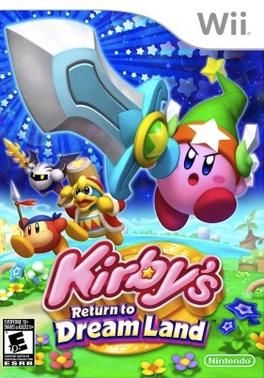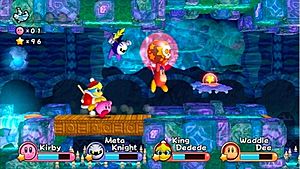Kirby's Return to Dream Land facts for kids
Quick facts for kids Kirby's Return to Dream Land |
|
|---|---|

North American box art
|
|
| Developer(s) |
|
| Publisher(s) | Nintendo |
| Director(s) | Shinya Kumazaki |
| Producer(s) |
|
| Artist(s) |
|
| Writer(s) | Shinya Kumazaki |
| Composer(s) |
|
| Series | Kirby |
| Platform(s) | |
| Release date(s) |
|
| Genre(s) | Action-platformer |
| Mode(s) | Single-player, multiplayer |
Kirby's Return to Dream Land is a fun platform game for the Wii console. In some places, it was called Kirby's Adventure Wii. This game was made by HAL Laboratory and released by Nintendo in 2011. It's a big part of the popular Kirby game series.
In this game, you join Kirby and his friends, King Dedede, Meta Knight, and Bandana Waddle Dee. They help an alien named Magolor. Magolor's spaceship, the Lor Starcutter, crashed on Kirby's home planet, Popstar. Your mission is to find the missing pieces of his ship so he can go back home.
Kirby's Return to Dream Land brought back the classic Kirby gameplay. This was exciting because the last traditional Kirby game for home consoles was Kirby 64: The Crystal Shards in 2000. The game was released in North America on October 24, 2011, and in other parts of the world soon after. A new version, Kirby's Return to Dream Land Deluxe, came out for the Nintendo Switch on February 24, 2023.
Contents
Playing the Game: How Kirby Works
Kirby's Return to Dream Land is a side-scrolling platform game. This means you move Kirby from left to right across the screen. Even though it looks 2D, the characters and enemies are made with 3D models. You control the game by holding the Wii Remote sideways.
Kirby's Special Abilities
Kirby has his famous ability to inhale, or suck up, objects and enemies. He can then either swallow them or spit them out as a fast projectile. If you shake the Wii Remote or inhale for a long time, Kirby can do a "Super Inhale." This is a much stronger inhale that can suck up bigger enemies or special "Heave-ho Blocks."
When Kirby swallows certain enemies, he gains "Copy Abilities." These abilities give him new attacks, like breathing fire or swinging a sword. Kirby can only have one Copy Ability at a time. If you are playing with friends, other characters can throw Copy Ability essences to Kirby.
New Copy Abilities
This game introduced some cool new Copy Abilities:
- Whip ability: Lets Kirby grab items that are far away.
- Water ability: Allows Kirby to put out fires.
- Leaf ability: Lets Kirby use leaves to attack or hide safely in a pile of leaves.
The Nintendo Switch version, Kirby's Return to Dream Land Deluxe, added even more:
- Mecha ability: Gives Kirby laser cannons and robotic arms.
- Sand ability: Allows Kirby to change sand into different shapes.
- The Festival ability from Kirby Star Allies also returned.
Super Abilities
The game also has powerful, temporary "Super Abilities." These are like super-charged versions of regular Copy Abilities. They can destroy parts of the environment and cause huge damage. There are five Super Abilities:
- Ultra Sword (enhanced Sword ability)
- Monster Flame (enhanced Fire ability)
- Flare Beam (enhanced Beam ability)
- Grand Hammer (enhanced Hammer ability)
- Snow Bowl (enhanced Ice ability)
Playing with Friends
You can play Kirby's Return to Dream Land with up to three friends! This is called cooperative multiplayer. Your friends can play as different colored Kirbys, or as Meta Knight, King Dedede, or Bandana Waddle Dee. Only the Kirbys can use Copy Abilities.
Players can stack on top of each other in a "totem." If you time it right, the player at the bottom can unleash a powerful "Team Attack." Players can also share health-restoring items with each other.
In the Switch version's new story mode, Magolor becomes a playable character. He starts with limited powers but gains more as you upgrade him.
Story: Kirby's Big Adventure
The story begins when a spaceship called the Lor Starcutter crashes on Popstar, Kirby's home planet. Kirby, Meta Knight, King Dedede, and Bandana Waddle Dee go to check it out. They meet Magolor, an alien who needs help. His ship's pieces and 120 energy spheres are scattered all over Popstar. Magolor promises to take them to his home planet, Halcandra, if they help him fix his ship.
Journey to Halcandra
After finding all the main ship pieces, Kirby and his friends travel to Halcandra. But when they arrive, a four-headed dragon named Landia attacks them! Magolor tells them Landia is an evil beast that has taken over Halcandra. So, Kirby and his friends defeat Landia.
Magolor's True Plan
After Landia is defeated, Magolor reveals his real plan. He wanted to steal the Master Crown from Landia's head! Magolor puts on the crown and becomes a giant, powerful monster. He plans to make the whole universe bow to him, starting with Popstar.
But Landia, who has now split into four smaller dragons, teams up with Kirby and his friends. They chase Magolor into another dimension. Magolor tries to stop them using the Lor Starcutter, but Kirby and his friends defeat the ship. Finally, they face Magolor in a huge final battle. Kirby and his friends destroy the Master Crown, and Magolor disappears. With the crown shattered, Kirby and friends return to Popstar. The Landia dragons take the Lor Starcutter and go home.
Magolor's Epilogue (Deluxe Version)
The Kirby's Return to Dream Land Deluxe game on Switch adds a new story called Magolor Epilogue: The Interdimensional Traveler. This story follows Magolor after his defeat. He is stuck in an unknown part of Another Dimension and has lost most of his powers. He tries to get his powers back and collect pieces of a mysterious fruit called the Gem Apple.
Magolor eventually fixes the Gem Apple seed. But then, the leftover power from the Master Crown corrupts it, turning it into a monster called the Crowned Doomer. After defeating it, the Master Crown's power combines with the Gem Apple, creating a huge tree-like being. Magolor fights and finally defeats the Master Crown for good. A portal opens, and Magolor leaves Another Dimension. The ending shows Magolor arriving in the Dream Kingdom, a parallel version of Dream Land. He plants the Gem Apple seed there, and it grows into a tree. Magolor becomes the shopkeeper in this new place, which sets up the events of other games like Team Kirby Clash Deluxe.
How the Game Was Made
Making a new Kirby game for the GameCube started way back in 2000, after Kirby 64: The Crystal Shards came out. This game had a very long development time, lasting 11 years! During this time, three different versions of the game were planned and then cancelled.
Early Ideas
The first idea was a 3D game that still played like a traditional 2D side-scroller, similar to Kirby 64. It was going to have multiplayer for up to four players. This version was shown at the E3 in 2005. However, it was hard to program the multiplayer, so this version was stopped. Some of its ideas, like the "Helper" system, were later used in Kirby Star Allies.
The second idea was an open world 3D game. The third idea went back to side-scrolling but had a unique "pop-up book" art style. The second idea was cancelled because it didn't meet the quality standards. But the team kept trying new 3D Kirby games, which eventually led to Kirby and the Forgotten Land.
Finding the Right Path
When the third idea was cancelled in 2010, Shinya Kumazaki became the director. The team realized that focusing too much on multiplayer had caused problems. So, they decided to focus on the single-player experience first, keeping multiplayer as a lower priority. Development of the final version sped up in October 2010, and the game started to take its final shape.
Because of its long development, the Kirby game often appeared and disappeared from Nintendo's lists of upcoming games. People wondered if it would ever be released. Finally, in January 2011, Nintendo officially announced the game again. It was shown at E3 2011 as Kirby Wii. Later, it got its final names: Kirby's Return to Dream Land in North America, Kirby's Adventure Wii in Europe and Australia, and Hoshi no Kirby Wii in Japan. The music for the game was created by Jun Ishikawa and Hirokazu Ando.
The Deluxe Version
On September 13, 2022, Nintendo announced an improved version of the game for the Nintendo Switch. This new version, Kirby's Return to Dream Land Deluxe, has new abilities like Mecha and Sand. It also has a cool new comic book-like art style and brand new mini-games. It was released on February 24, 2023.
Images for kids
See also
 In Spanish: Kirby's Return to Dream Land para niños
In Spanish: Kirby's Return to Dream Land para niños



